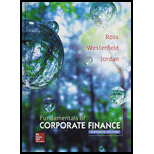
Concept explainers
Credit Policy Evaluation [LO2] The Johnson Company sells 2,400 pairs of running shoes per month at a cash price of $99 per pair. The firm is considering a new policy that involves 30 days’ credit and an increase in price to $100 per pair on credit sales. The cash price will remain at $99, and the new policy is not expected to affect the quantity sold. The discount period will be 20 days. The required return is .75 percent per month.
a. How would the new credit terms be quoted?
b. What investment in receivables is required under the new policy?
c. Explain why the variable cost of manufacturing the shoes is not relevant here.
d. If the default rate is anticipated to be 8 percent, should the switch be made? What is the break-even credit price? The break-even cash discount?
Want to see the full answer?
Check out a sample textbook solution
Chapter 20 Solutions
Fundamentals of Corporate Finance with Connect Access Card
- I need assistance with this financial accounting questionarrow_forwardGiven the following information concerning a convertible bond: a. What is the current yield of this bond? ANSWER: 4.8% b. What is the value of the bond based on the market price of the common stock? ANSWER: $864 c. What is the value of the common stock based on the market price of the bond? ANSWER: $38.52 d. What is the premium in terms of stock that the investor pays when he or she purchases the convertible bond instead of the stock? ANSWER: $176 e. Nonconvertible bonds are selling with a yield to maturity of 7 percent. If this bond lacked the conversion feature, what would the approximate price of the bond be? ANSWER: $817 f. What is the premium in terms of debt that the investor pays when he or she purchases the convertible bond instead of a nonconvertible bond? ANSWER: $223 g. If the price of the common stock should double, would the price of the convertible bond double? Briefly explain your answer. ANSWER: At least $1,728 h. If the price of the common stock should decline by 50…arrow_forwardI need help with financial accounting questionarrow_forward
- Agreee or disagree with post The temporary value of money (TVM) is an important concept in finance. TVM states that the money available now is worth more than the same amount in the future. This is because money can earn interest over time. A key assumption of this model is that money will obtain consistent performance. This assumption helps people make decisions about savings, investment and spending. For example, knowing that money grows can motivate people to save for future objectives. However, this model has limitations. The assumption of consistent yields may not be true in real life due to changes in the market or economic conditions. Therefore, although the temporal value of money is useful for planning, it is essential to consider the risks and uncertainties in financial decision making. Agree or disagree with postarrow_forwardWhat is the time value of money concept? Explain one of the assumptions behind the TVM model. How does this assumption limit the application of this model?arrow_forwardagree or disagree with post TVM or time value of money is the suggestion that todays currency will be more profitable in the future. This concept comes from the action of investing, which produces returns and in short monopolizes the investment. One of the biggest assumptions behind the TVM model is that the economic conditions will remain steady enough to produce a profit for the consumer. This model does not account for inflation, fluctuation of the market, and even different government actions which can impact the economy. This limits the application of the model because it is not accurate and due it being based off of a growing interest rate only which we all know is not the case. Investing can be unpredictable and ever changing so that needs to be taken into account in models such as these. agree or disagree with postarrow_forward
- How are HRISs changing how companies manage their compensation and benefit plans?arrow_forward3. A bond's yield to maturity (YTM) is:A. The coupon rateB. The rate of return required by investorsC. The market price of the bondD. The par value of the bondarrow_forwardNeed help The time value of money concept suggests:A. A dollar today is worth less than a dollar tomorrowB. Money loses value over time due to inflationC. A dollar today is worth more than a dollar in the futureD. Interest has no effect on present valuearrow_forward
 EBK CONTEMPORARY FINANCIAL MANAGEMENTFinanceISBN:9781337514835Author:MOYERPublisher:CENGAGE LEARNING - CONSIGNMENT
EBK CONTEMPORARY FINANCIAL MANAGEMENTFinanceISBN:9781337514835Author:MOYERPublisher:CENGAGE LEARNING - CONSIGNMENT

